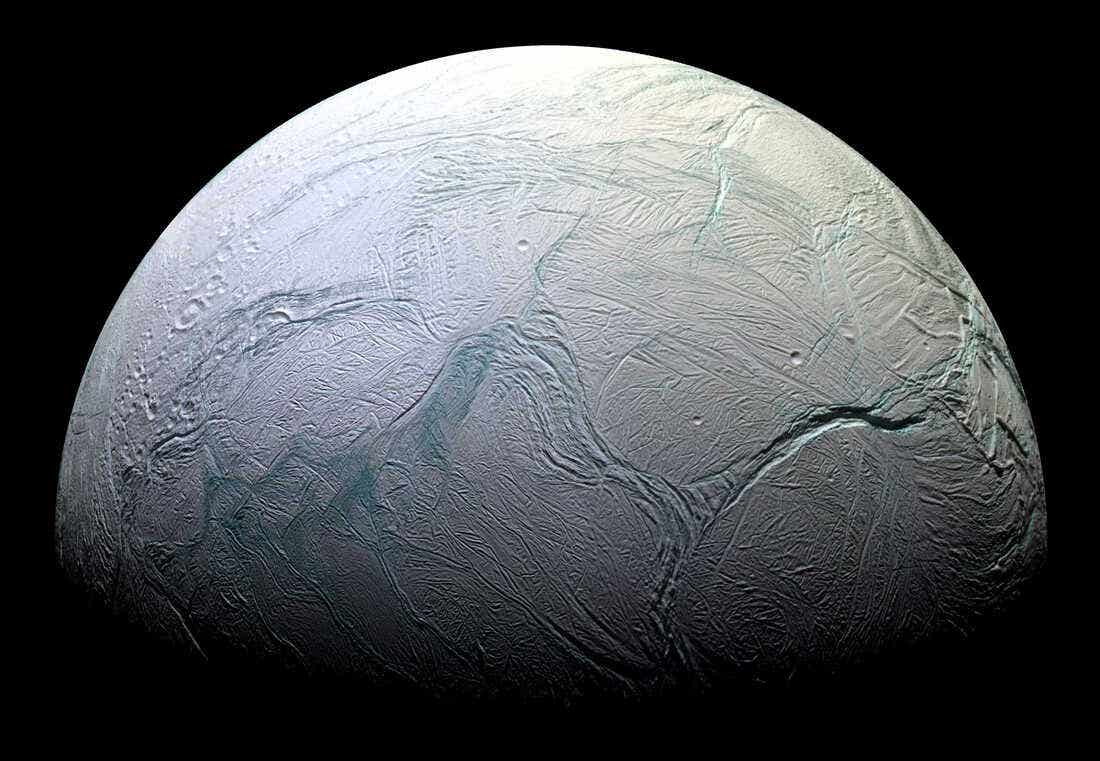Groundbreaking laser can help detect signs of life on other planets
The laser-sourced analyzer is significantly smaller and more resource-efficient than its predecessors—all without compromising its abilities

[Jan. 23, 2023: Georgia Jiang, University of Maryland]
Saturn's icy moon Enceladus is considered one of the likeliest extraterrestrial places to find life. (CREDIT: NASA/JPL-Caltech/Space Science Institute)
As space missions expand farther into the outer solar system and the hunt for extraterrestrial life and habitable planets and moons accelerates, the need for more compact, resource-conserving and accurate analytical tools is increasingly critical.
A University of Maryland-led team developed a new instrument tailored to the needs of NASA space missions. The mini laser-sourced analyzer is significantly smaller and more resource-efficient than its predecessors—all without compromising its ability to examine planetary material samples and potential biological activity onsite. The team’s paper on the device was published Monday in the journal Nature Astronomy.
Weighing just 17 pounds, the instrument is a scaled-down combination of two important tools for detecting signs of life and identifying compositions of materials: a pulsed ultraviolet laser that removes small amounts of material from a planetary sample and an Orbitrap analyzer that delivers high-resolution data about the chemistry of materials. Its diminutive mass and power requirements mean the instrument can be easily stowed away and maintained on space mission payloads, and its analyses of planetary surfaces are less intrusive and thus much less likely to damage or contaminate a sample than many current methods of identifying unknown compounds.
“You can find (the Orbitrap) in the labs of pharmaceutical, medical and proteomic industries,” said Ricardo Arevalo, lead author of the paper and an associate professor of geology at UMD. “The one in my own lab is just under 400 pounds, so they’re quite large, and it took us eight years to make a prototype that could be used efficiently in space … but still capable of cutting-edge science.”
Related Stories
The team’s new gadget shrinks down the original Orbitrap while pairing it with laser desorption mass spectrometry (LDMS), a technology likewise has not been applied in an extraterrestrial planetary environment.
“The good thing about a laser source is that anything that can be ionized can be analyzed. If we shoot our laser beam at an ice sample, we should be able to characterize the composition of the ice and see biosignatures in it,” Arevalo said. “This tool has such a high mass resolution and accuracy that any molecular or chemical structures in a sample become much more identifiable.”
The laser component of the mini LDMS Orbitrap also allows researchers access to larger, more complex compounds that are more likely to be associated with biology. Smaller organic compounds like amino acids, for example, are more ambiguous signatures of life forms.
A mini laser-sourced analyzer (below) developed by a UMD team is significantly smaller and more resource-efficient than its predecessors—all without compromising its ability to examine planetary material samples and potential biological activity far from our planet. (CREDIT: Lori Willhite and Ricardo Arevalo)
“Amino acids can be produced abiotically, meaning that they’re not necessarily proof of life. Meteorites, many of which are chock full of amino acids, can crash onto a planet's surface and deliver abiotic organics to the surface,” Arevalo said. “We know now that larger and more complex molecules, like proteins, are more likely to have been created by or associated with living systems.”
For Arevalo and his team, the mini LDMS Orbitrap will offer much-needed insight and flexibility for future ventures into the outer solar system, including missions focused on life-detection objectives, such as the Enceladus Orbilander, and exploration of the lunar surface, like the NASA Artemis Program. They hope to send their device into space and deploy it on a planetary target of interest within the next few years.
Photo of the CORALS breadboard laser, which meets the performance requirements of the ETU design, at NASA Goddard Space Flight Center. (CREDIT: Nature Astronomy)
“Our mini Orbitrap LDMS instrument has the potential to significantly enhance the way we currently study the geochemistry or astrobiology of a planetary surface,” Arevalo said.
Other UMD-affiliated researchers on the team include geology graduate students Lori Willhite and Ziqin “Grace” Ni, geology postdoctoral associates Anais Bardyn and Soumya Ray, and astronomy visiting associate research engineer Adrian Southard.
Note: Materials provided above by University of Maryland. Content may be edited for style and length.
Like these kind of feel good stories? Get the Brighter Side of News' newsletter.



